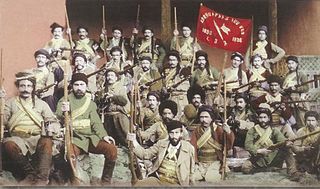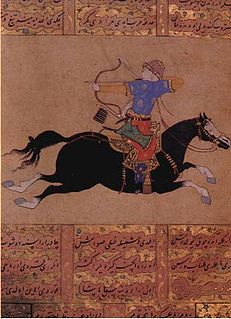 W
WFedayi, also known as the Armenian irregular units or Armenian militia, were Armenian civilians who voluntarily left their families to form self-defense units and irregular armed bands in reaction to the mass murder of Armenians and the pillage of Armenian villages by criminals, Kurdish gangs and Turkish forces, and Hamidian guards during the reign of Abdul Hamid II in late 19th and early 20th centuries, known as the Hamidian massacres. Their ultimate goal was always to gain Armenian autonomy (Armenakans) or independence depending on their ideology and the degree of oppression visited on Armenians.
 W
WConcluded on 30 October 1918 and taking effect at noon the next day, the Armistice of Mudros ended hostilities in the Middle Eastern theatre between the Ottoman Empire and the Allies of World War I. It was signed by the Ottoman Minister of Marine Affairs Rauf Bey and British Admiral Somerset Arthur Gough-Calthorpe, on board HMS Agamemnon in Moudros harbor on the Greek island of Lemnos.
 W
WThe Aviation Martyrs' Monument, located in Fatih district of Istanbul, Turkey, is a memorial dedicated to the first soldiers of the Ottoman Airforce to be killed in flight accidents. In Turkey, one use of the term "martyr" is as an honorific for people killed in action during war.
 W
WThe Edirne Incident was a janissary revolt that began in Constantinople in 1703. The revolt was a reaction to the consequences of the Treaty of Karlowitz and Sultan Mustafa II's absence from the capital. The rising power of the sultan’s former tutor, Şeyhülislam Feyzullah Efendi and the empire's declining economy caused by tax farming were also causes of the revolt. As a result of the Edirne Event, Seyhulislam Feyzullah Efendi was killed, and Sultan Mustafa II was ousted from power. The sultan was replaced by his brother, Sultan Ahmed III. The Edirne Event contributed to the decline of the power of the sultanate and the increasing power of the janissaries and kadis.
 W
WGunpowder Empires or Islamic Gunpowder Empires refers to the Ottoman, Safavid and Mughal empires as they flourished from the 16th century to the 18th century. These three empires were among the strongest and most stable economies of the early modern period, leading to commercial expansion, and greater patronage of culture, while their political and legal institutions were consolidated with an increasing degree of centralisation. The empires underwent a significant increase in per capita income and population, and a sustained pace of technological innovation. They stretched from Central Europe and North Africa in the west to between today's modern Bangladesh and Myanmar in the east.
 W
WThe Krastata Kazarma is a former military facility of the Ottoman Empire. The barracks got its name due to its cross-shaped architecture. It is one of the cultural memorials of the region of Vidin, Bulgaria, today.
 W
WThe Nizam-ı Cedid Army refers to the new military establishment of the Nizam-ı Cedid reform program. The Nizam-i Cedid army was largely a failure in its own time, but proved to be a much more effective infantry force than the Janissaries.
 W
WSelimiye Barracks, also known as Scutari Barracks, is a Turkish Army barracks located in the Üsküdar district on the Asian part of Istanbul, Turkey. It was built first in 1800 by Sultan Selim III for the soldiers of the newly established Nizam-ı Cedid in frame of the Ottoman military reform efforts.
 W
WTurkish archery is a tradition of archery which became highly developed in the Ottoman Empire, although its origins date back to the Eurasian Steppe in the second millennium BC.
 W
WUdch or Uch (اوج) is an Ottoman military corridor for offensive. The historiographic term also describes a frontier, often controversial territory in medieval Balkan in the territory of Asia Minor, and later at the dawn of the Ottoman Empire - on the Balkan Peninsula. The Ottoman military leader distributes landed property located on the border of the established state to his followers and wars, in return for their obligation to protect the border from external enemies, as a rule, believers.